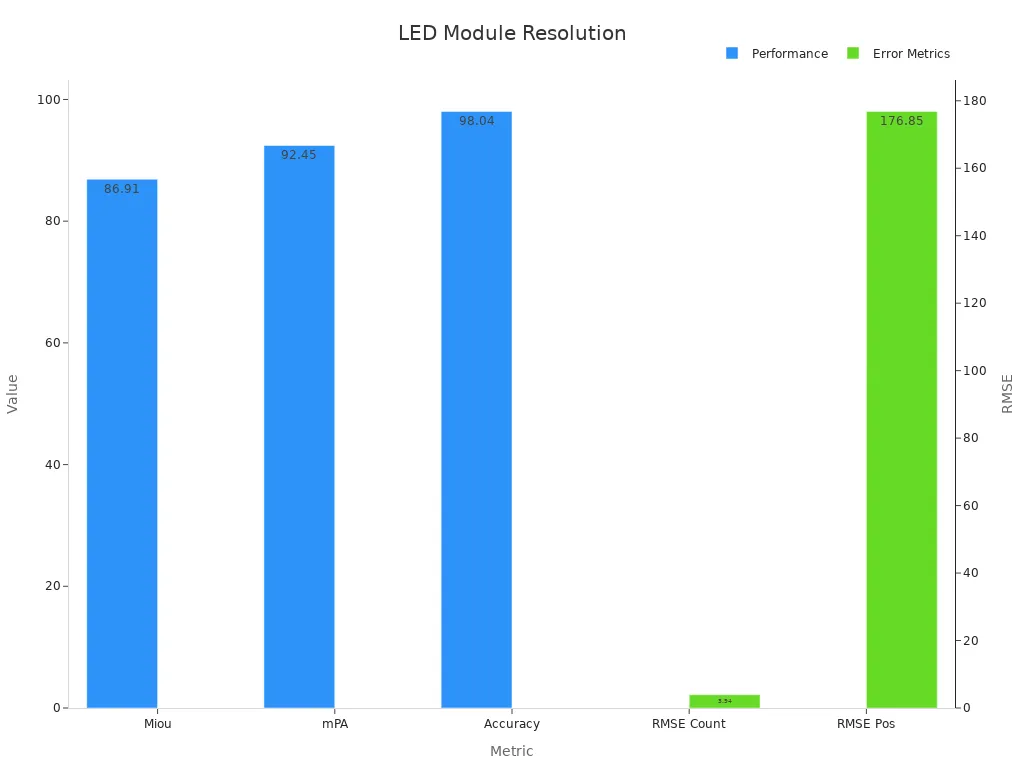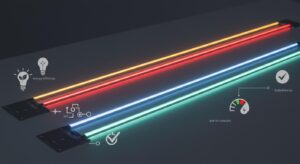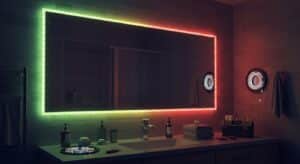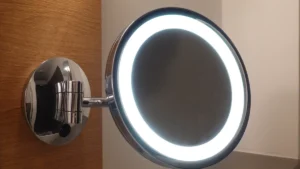
Have you noticed that LED module screens are everywhere now? They are super bright, clear, and colorful. The LED module screen market is growing fast, potentially expanding from $6.2 billion in 2023 to $12.9 billion by 2032. There are options like the p1.5 LED module screen for sharp pictures or the p2.5 LED module screen for a lower cost. These screens work really well. Their design makes displays smooth indoors or outdoors. They also save energy, so they are good for the planet and your wallet.
Key Takeaways
LED screens are bright and clear, perfect indoors or outdoors.
Their design makes them easy to fix and customize, lasting longer.
Picking the right LED, like p1.5 for clear pictures or p2.5 to save money, improves your display.
High-Quality Visual Performance

LED module screens look amazing with their bright, clear visuals. Let’s explore why they are so great in brightness, resolution, and color.
Brightness
LED screens stay bright even in sunlight. This is because they are built for high brightness levels. Brightness is measured in nits, and LED screens often beat other displays. For example, AOTO’s LED cinema screens passed 36 tough tests to earn DCI certification. These tests check for even brightness, small errors, and great color quality.
Here’s a simple look at brightness checks:
Test Type | Details |
|---|---|
DCI CTP Certification | AOTO screens passed 36 tests to prove their high performance. |
Quality Control Steps | Includes 14 mechanical, 9 optical, and 9 electrical performance tests. |
Testing Standards | Ensures even brightness, low errors, and great color accuracy. |
The ANSI/IES LM-79-24 standard is used worldwide to test LED brightness and energy use. It ensures LED screens are bright and efficient.
Resolution
Resolution makes images sharp and detailed. LED screens have tiny pixels that create clear pictures. Whether you pick a p1.5 LED module for sharp images or a p2.5 for saving money, the resolution stays excellent. These screens are made for clear and steady visuals.
Here’s a quick look at resolution metrics:
Metric | Value |
|---|---|
Miou | 86.91% |
mPA | 92.45% |
Accuracy | 98.04% |
RMSE (Defects) | 3.94 |
RMSE (Position) | 176.85 |

These numbers show LED screens are accurate and have few errors. This means you get a perfect display every time.
Color Accuracy
LED screens are great at showing true colors. You want colors to look real, right? Advanced tools like RGB sensors help make this happen. These sensors ensure colors are accurate, making LED screens perfect for industries like car displays and testing.
Here’s how it works:
Special sensors check colors carefully, like lab-grade tools.
RGB sensors from Hamamatsu adjust color and brightness evenly.
The modular design makes them reliable and easy to maintain.
Hamamatsu sensors also measure colors quickly, improving control. This is important when exact colors are needed.
With LED screens, you see bright, real colors that stand out. Whether you choose a p1.5 for sharp details or a p2.5 for saving money, the colors always look amazing.
Advanced Technology in LED Module Screens
LED module screens use smart technology to stand out. Their modular design, energy-saving features, and durability make them reliable. Let’s explore what makes these screens so special.
Modular Design
The modular design of LED screens is very useful. It lets you change or expand the screen size easily. Whether for a big outdoor sign or a small indoor display, the modular setup works well.
Each module works on its own. If one part breaks, you can fix it without affecting the rest. The modules fit together smoothly, creating a perfect display.
Here’s a simple comparison of two scanning methods used in LED screens:
Aspect | 1/8 Scan Display | 1/32 Scan Display |
|---|---|---|
Refresh Rate | 7680 Hz | 3840 Hz |
SPWM Scrambles | 128 | 64 |
Camera Compatibility | No scan lines for rolling shutter | May show scan lines for rolling shutter |
Suitable For | High-quality video | Budget-friendly setups |
For top-quality videos, pick the 1/8 scan display. For saving money, the 1/32 scan display is a good choice. Either way, the modular design gives you a flexible and dependable screen.
Energy Efficiency
LED screens are not just bright—they save energy too. They use much less power than older displays, making them eco-friendly.
With advanced tech, LED screens can cut energy use by 50%. This lowers your electricity bills and helps the environment.
Here’s a quick look at their energy-saving features:
Feature | Details |
|---|---|
Energy Saving | ≥50% |
Low Power Consumption | Energy saving ≥30% |
Patent Techniques | 28 main patented technologies |
Environmental Benefits | Total energy saving ≥50% |
These features let you enjoy bright screens without high energy costs. Whether you choose a p1.5 or p2.5 LED module, you’ll save power and money.
Durability
LED screens are built to last a long time. They work well even in tough conditions like extreme heat or heavy use.
LED modules go through strict tests to check their durability. For example, lumen maintenance tests show how bright the screen stays after many hours of use. High-lumen maintenance means the screen stays bright for years.
Here’s how durability testing works:
Key Aspect | Overview | Importance |
|---|---|---|
Lumen Maintenance | Measures light output after 6,000-10,000 hours. | High-lumen maintenance means long-lasting brightness. |
Testing Duration | Simulates long-term use over time. | Helps predict how long the product will last. |
Extrapolation of Lumen Maintenance | Predicts brightness over the product’s life. | Helps buyers know how durable and cost-effective the screen is. |
Test Conditions | Includes temperature and power settings. | Ensures the screen works well in different environments. |
When you buy a p1.5 or p2.5 LED module, you’re getting a strong and long-lasting product. These screens keep working great, making them a smart choice for any use.
Versatility and Applications of LED Screens

LED module screens are super flexible. They work well in many places. Whether indoors or outdoors, they perform great. Let’s see how they fit different needs.
Indoor and Outdoor Use
LED screens are useful inside and outside. Outdoor screens handle bad weather and stay bright in sunlight. They often have over 5000 nits of brightness. You’ll see them on billboards, stadiums, and public boards.
Indoor screens focus on clear pictures and saving energy. They’re great for malls, airports, and offices. They use less brightness but still look sharp. A p1.5 LED module gives clear images for close viewing. A p2.5 LED module is cheaper and works well too.
Feature | Outdoor LED Screens | Indoor LED Screens |
|---|---|---|
Brightness | Over 5000 nits | Lower brightness for indoor lighting |
Durability | Handles bad weather | Made for indoor spaces |
Energy Efficiency | Moderate | Saves more energy |
Customization Options
LED screens can be made to fit your needs. You can pick the size, shape, or even curve of the screen. Need a curved screen for a store? Easy. Want a big flat screen for a concert? No problem. The modular design makes it simple.
For example, a p1.5 LED module is great for sharp displays in malls. A p2.5 LED module is better for big, budget-friendly setups in churches. This makes LED screens popular for events and businesses.
Use Cases (e.g., Advertising, Events)
LED screens are everywhere. They’re great for ads and events. You can change what’s on the screen instantly. Imagine a billboard that updates fast or a concert screen that matches the music.
Here are common uses:
Advertising: Bright visuals grab attention in stores or on highways.
Events: Screens show live updates at concerts or sports games.
Corporate Communication: Perfect for meetings or office signs.
Application Type | Description | Examples |
|---|---|---|
Advertising | Eye-catching visuals in different places. | Billboards, Store Displays |
Events | Fun and useful content for shows and games. | Concerts, Sports Events |
Corporate Communication | Updates and messages for workers or visitors. | Meeting Screens, Office Signs |
LED module screens are changing how we share information and entertain. Whether you pick a p1.5 LED module for sharp images or a p2.5 LED module for saving money, these screens are amazing.
User Benefits of LED Module Screens
Cost-Effectiveness
LED screens help save money over time. They lower energy and repair costs. For instance, LEGDATECH LED screens cut energy bills by 67%. Over ten years, this could save you ¥440,000! Outdoor LED screens also boost ad income by 30%. Their bright colors and high visibility attract more customers, increasing profits.
When budgeting, think about all expenses. These include buying, setting up, and occasional repairs. Keep extra funds for unexpected fixes. Choose a p1.5 LED module for sharp images or a p2.5 for a cheaper option. Both fit different needs and budgets.
Easy Maintenance
Taking care of LED screens is easy. Tools help find problems fast with checks like looking, listening, or testing. Repairs focus on fixing specific parts, like modules or controls. Keeping spare parts ready means quick fixes when needed.
For example, regular checks and replacing old parts keep screens working well. This avoids big problems. Whether using a p1.5 for clear indoor displays or a p2.5 for outdoor use, maintenance is simple and affordable.
Maintenance Process | Description |
|---|---|
Accurate Diagnosis | Finds problems fast with checks and tests. |
Targeted Repair Plans | Fixes only the broken parts. |
Spare Parts Management | Keeps extra parts ready for quick repairs. |
Longevity
LED screens last a long time. With care, they can work for over 10 years. Kevin Izatt from Samsung says, “Some displays have lasted 15 years with great brightness.” This makes them a smart choice for long-term use.
LED screens can last 100,000 hours, twice as long as LCDs. Good airflow, strong power supplies, and smart designs help them last. Outdoor screens need to handle weather well. A p1.5 LED module is great indoors, while a p2.5 works well outside. Both are durable and reliable.
“The diode is just one part of an LED screen’s lifespan,” says Izatt. Good design and care keep screens working for years.
Type of Display | Estimated Lifespan |
|---|---|
LED | 100,000 hours |
LCD | 50,000 hours |
LED screens are a great investment. They perform well and last for many years.
LED module screens are amazing because of their smart tech, bright visuals, and many uses. Whether you want a sharp P1.5 module or a budget-friendly P2.5 module, there’s a choice for everyone. The market is growing fast and could reach $17 billion by 2032. These screens are strong, save energy, and are a great buy.
Metric | Value |
|---|---|
Market Size (2023) | About $10 billion |
Projected Market Size (2032) | Close to $17 billion |
CAGR (2023-2032) | 6.5% |
Key Drivers | Need for clear displays, better tech, and more uses in industries |
LED screens are changing how businesses work with their great performance and flexibility. From ads to events, they show eye-catching visuals that grab attention.
FAQ
Why are LED screens better than older displays?
LED screens are brighter, use less energy, and last longer. Their modular design makes fixing and customizing them simple for different uses.
What role do pixels play in LED screen quality?
Pixels control how clear an LED screen looks. Smaller pixels make sharper pictures, great for close viewing or HD content.
Are LED screens good for outdoor use?
Yes, LED screens work well outside. They can handle bad weather and stay bright in sunlight, so they’re easy to see anytime.
See Also
Improving Sign Board Illumination with LED Modules
The Advantages of Choosing LED Modules for Signage
Key Tips for Selecting the Perfect LED Sign Module
Comparing Edge-lit and Backlit LED Lights for Displays
Illuminate Your Signs Effortlessly with SUNLITE LED Modules



